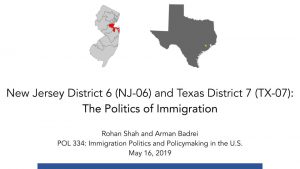
Arman Badrei and Rohan Shah
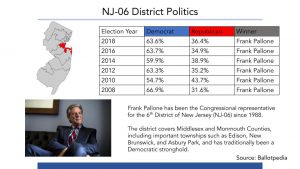
In the 6th congressional district of New Jersey (NJ-06), Congressman Frank Pallone has represented his constituents since 1988, winning his elections in the last decade by large margins. The district, which covers Middlesex County and Monmouth County, has been a Democratic stronghold.
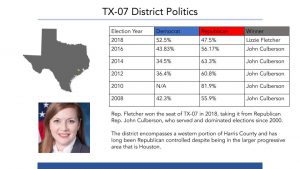
The 7th congressional district of Texas (TX-07) was represented by Representative John Culberson of the Republican Party for more than a decade. In the 2018 midterm elections, Congresswoman Lizzie Fletcher turned TX-07 blue.
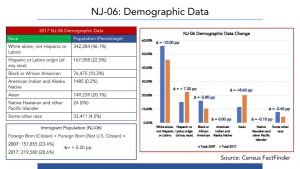
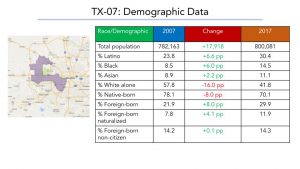
Both NJ-06 and TX-07 are majority-minority districts as of 2017. Over a ten-year period since 2007, the white population decreased, while Latino and Asian populations increased in both districts. The white population decline was greater in TX-07 but the growth of the Latino and Asian populations were slightly greater in NJ-06. The foreign-born, or immigrant, populations expanded in both districts, with a 5.2 percentage point increase in NJ-06 compared to an 8 percentage point increase in TX-07.

We both used certain scholarly work as a framework and motive for analyzing certain factors and larger themes. In the examination of NJ-06, Chavez (2008) and Abrajano and Hajnal (2015) predicted that changes to the Asian population demographic neither caused the same negative reactions nor shifts in macropartisanship as that of changes in the Latino population. TX-07 proved to also be especially interesting under the lens of existing research. According to research by Hopkins (2015), public opinion in areas can change as a result of “sudden, destabilizing changes” in local demographics. On a related note, Abrajano and Hajnal (2015) assert that whites living in states with more Latinos will tend to counter that growth by supporting more restrictive policymaking and movement towards the Republican Party.

To determine the accuracy of overlaying such research on our districts, we both conducted qualitative interview studies. The research concerning NJ-06 focused on evaluating the differences in perception to immigration news coverages of Asians versus Latinos. In exploring that significant aim, the research examined exposure to local and national news, perceived fairness of such news in respect to immigration, opinions of ethnic groups, and the effects of immigration news media on political affiliation and views. Interviews were conducted with Asian, Hispanic, Asian-Indian, and Non-Hispanic white constituents in NJ-06.

Although the research on TX-07 had a media-centric angle, the study focused far more on the perception and effects of the growth of ethnic populations. Interviews were conducted with Christopher Harvey, the Legislative Assistant on Immigration for Rep. Fletcher, and Gislaine Williams, the Community Relations Director at The Alliance, a nonprofit that works with primarily refugees but also immigrants. Main topics of the interviews were the reception of immigrants, the effects of demographic changes, urban attitudes on immigration, and the political situation and attitudes of the district in general.
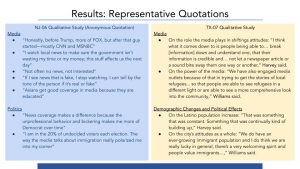
In comparing our results, we noted an intersection when evaluating the response to immigration politics in the media and demographic changes on the politics of each district. We included sample quotations that pertain to these categories.

In terms of media coverage, in NJ-06, interviewees held a fundamental distrust of both the local and national news media. Furthermore, media coverage of Asian immigration was seen as positive and advantageous for the American economy whereas that of the Latino population was believed to be negative and visceral. Significantly, the current immigration news coverage climate was determined to have a polarizing effect on personal political affiliation. In TX-07, both policymakers and nonprofit advocates understand the obvious influence of the media. Additionally, policymakers want to emphasize the danger of the dissemination of fake news. Now, in addition to being service providers for immigrant communities and entities for advocacy, it seems nonprofits are turning towards functioning as an instrument or facilitator in the media world too: Williams at The Alliance talked about how they “have also engaged media outlets because of that in trying to get the stories of local refugees in newspapers, in local news, local TV news, so that people are able to see refugees in a different light or are able to see a more comprehensive look into the community” and have led media training for refugee leaders to teach them how to write opinion pieces and press releases.
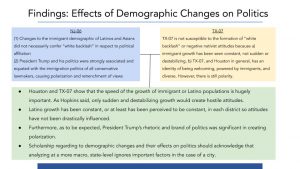
Both NJ-06 and TX-07 saw increases in the immigrant and Latino populations but our research indicates that this did not necessarily confer “white backlash” in respect to political affiliation. This is because the speed of such growth was rather constant, or perceived to be constant, and because President Trump’s politics played a more pivotal role than the issue of immigration which points to the rise in Democratic success since 2016. Polarization exists, but more so due to Trump rather than views on immigration specifically.

We recommend that our representatives, first and foremost, represent the views of all their constituents including citizens and non-citizens. However, we do understand the challenge in doing so. In TX-07, Harvey emphasized the difficulty in having polarity due to immigration and representing the views of a moderate district. Out of respect for the American electoral system, they should take a position that accommodates as many residents as possible. As the moderate nature of TX-07 demonstrates, simply representing based on the interests of political partisanship would ignore a large (or more specifically, half) of the electorate. Given the prevalence of immigration media coverage, representatives should actively demystify immigration policy decisions at the local and national levels to counter “fake news”, biases in the media, and transparency issues. As demonstrated with TX-07 and NJ-06, representatives should actively respond to demographic changes by having prescience about immigrant attitudes and promoting cross-cultural awareness to mitigate potential issues.









